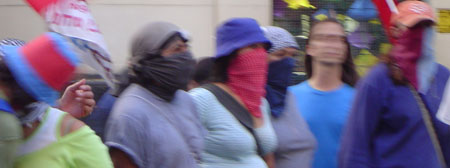When I think of late 19th century anarchists I tend to imagine some slovenly dressed, ratty haired, vaguely Russian looking dude. But there were some women among those hell raisers and they even had a newspaper, La Voz de la Mujer.
So I learned from reading “No God, No Boss, No Husband: Anarchist Feminism in Nineteenth-Century Argentina” by Maxine Molyneux. (Latin American Perspectives, Vol 13, No. 1 (Winter 1986) 119 – 145).
The anarchist movement in the Buenos Aires of the 1890s stemmed from sectors of the city’s European immigrant communities. Molyneux describes La Voz de la Mujer as being “one of the first expressions of what was to be Argentina’s Anarchist heyday“. Indeed, the fact that there was such a large anarchist movement indicates that Buenos Aires was never really just the city of elegance that my blog’s title so wistfully evokes.
First appearing on January 8, 1896 La Voz de la Mujer was published 9 times over the course of 1896 with more than 1,000 copies printed for each issue. Each issue was four pages printed on 26cm x 36cm paper. The newspaper was short-lived, ceasing publication just after one year.
A few years ago a facsimile edition of the paper was published by the Universidad Nacional de Quilmes. Molyneux says very little about the publishers of La Voz de la Mujer, alluding that since the focus was anarchism then the originators were rather publicity shy. A beautiful actress was rumored to be one of the editors.
Many of the articles were signed though most likely all were pseudonyms. And what were some of the values promoted through La Voz de la Mujer?
- Abolition of marriage
- An end to unequal and restricted opportunities for women
- Ending discrimination against women in the workplace
- Eradicating domestic slavery
- Equal access to education
Vice & Free Love in Buenos Aires
At the time Buenos Aires was already on its way to becoming the vice capital of Latin America (a list on which it probably still ranks fairly high). As a feminist voice it’s not surprising that La Voz de la Mujer was sympathetic towards the plight of prostitutes: “The editors held that prostitution was forced on women through poverty, men’s rapacity, and the lack of realistic alternatives for earning their living.”
Free love was one concept promoted by La Voz de la Mujer, though that didn’t equate to sexual abandon. And not all anarchists were of the same mind. There’s the story of one male anarchist who shot his lover five times as she attempted to leave him. Fortunately for her, he was a bad shot (perhaps not having read his anarchist training manual too closely) and she survived.
Molyneaux tells us that the editors of La Voz de la Mujer felt that “‘Degenerate’ sex, including masturbation, was associated with the enemy, especially priests and the bourgeoisie, who were berated as homosexuals and pederasts.” Obviously there were limits to the open-mindedness of even feminist anarchists in 1896, but they did like attacking the Church.
Here’s a rather interesting story appearing in La Voz de la Mujer that a “Luisa Violeta” claimed to be autobiographical. The setting is a confessional, a priest, and Luisa:
The priest rebukes her for not attending mass. She explains that her mother has been
ill and she has had to care for her, but the priest will have none of it: “Disgraceful
girl, don’t you know that it is the soul first and then the body . . . ?” In the course of the confession Luisa asks forgiveness for masturbating, a subject that provokes a keen interest on the other side of the grille. The priest wants to know exactly what parts of her body she touches and whether she performs these acts alone; then he asks her whether she was taught to do this by someone else. She retorts that it was none other than the priest himself. At this point, he invites her into his cubicle and tries to rape her.
Voices Replaced
While it’s a colorful bit of the city’s history La Voz de la Mujer had little impact on the Buenos Aires of its day. Over the years more women would come along but they would be socialists rather than anarchists. And more than a hundred years later women are still found in the social militancy of Buenos Aires.

July 18th, 2007 at 12:41 pm
Hola from the NW!
Wonderful blog! I found it far more interesting than the title indicates.Very interesting topics you choose!
July 18th, 2007 at 4:27 pm
Hi Francisco – thanks for the nice words!
May 23rd, 2008 at 6:56 pm
have you read donna guy’s sex and danger in buenos aires?
great blog!
May 24th, 2008 at 12:57 pm
Hi Patricia,
I’ve not yet read Donna Guy’s book. It’s one I’ve been wanting to read for a long time but can’t find here in BA. I should just get around to ordering it. I have read several articles by Guy and enjoyed those, so I’m sure the book is very insightful.
Thanks for the compliment on the blog!
October 24th, 2008 at 3:30 pm
Dear all,
I am researching ‘la voz de la mujer’ for a PhD project at Warwick University (England). I would be really grateful if someone could point me to translations into English or other languages.
Best wishes,
Monica
mmoremora@hotmail.com
&&&&&&&&&&&&&&&&&&&&&&&&&&&&&&&&&&&&&&&&&&&&&&&&&&
Estoy investigando ‘La voz de la mujer’ entre otros textos para un proyecto de doctorado.
Me sería de gran ayuda si alguien pudiera comentarme sobre las traducciones al inglés (o a otros idiomas) de estos textos.
Un abrazo,
Monica
mmoremora@hotmail.com